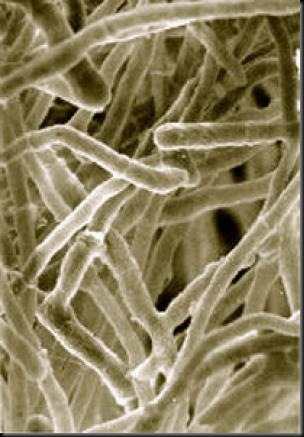The fungus Trichoderma reesei optimally breaks down plants into simple sugars, the basic components of ethanol. The fungus's genome has recently been sequenced by researchers from the Architecture et fonction des macromolécules biologiques laboratory (CNRS/Université de la Méditerranée and Universite de Provence), working together with an American team. The results show that only a few genes are responsible for the fungus's enzymatic activity. They offer new avenues for the fabrication of second generation biofuels from plant waste.
The fungus Trichoderma reesei was discovered in the South Pacific during the Second World War, where it was damaging American military equipment and was defeating every attempt at protecting the equipment with cotton cloth. The fungus contains a number of enzymes, cellulases, with potent catalytic properties that break down plants. It is considered to be the world’s most efficient fungus at breaking down the cellulose in plant cell walls into simple sugars, which it feeds on.
After fermentation, simple sugars can easily be transformed into biofuels such as ethanol. First generation agrofuels, made from grain or from beet, have certain limitations. Second generation biofuels, made from foresting and agricultural waste (tree cuttings, corn cobs, straw, etc.) do not have these limitations, as they complement pre-established agricultural activity, have a better CO2 balance, et don’t interfere with the agro-alimentary cycle. To produce these second generation biofuels, industrialists are looking to develop fungus strains capable of producing a cocktail of cellulases and hemicellulases at a concentration of 50 g/l. Trichoderma reesei is the choice organism for most projects in this field.
Bernard Henrissat’s glycogenomic team at the Architecture et fonction des macromolécules biologiques lab specializes in the study of enzymes which break down sugars.* In order to learn more about the incredible enzymatic activity of Trichoderma reesei, they assayed its genome. They found that the fungus has an unexpectedly small number of genes encoding cellulases (hemicellulases and pectinases), many fewer in fact than in usually found in fungi capable of breaking down plant cell walls. Moreover, the fungus has no or very little enzymatic activity allowing the digestion of specific components in the cell wall.
This was first interpreted as bad news, but the limitations of this model organism are now being seen as something positive. The fungus’s enzyme cocktail lends itself to numerous genetic modifications, and researchers are looking into which other enzymes can be added to the fungus’s gene sequence in order to make it even more efficient at producing bioethanol.
*The laboratory has a perfected Carbohydrate-Active Enzymes (CAZy) database which describes a number of enzyme families which form and destroy bonds between sugars.
Source:Science Daily


2 comments:
Thanks for this! Very informative!
you are welcome!!
Post a Comment